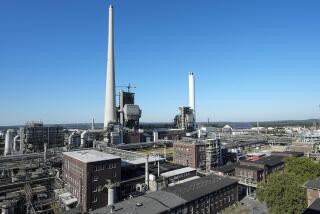U.S. Brainpower Helps Fuel Electrification of the Far East
- Share via
One of the most significant business stories of the decade is unfolding in the massive building of electric power plants in Asia, with U.S. companies, perhaps surprisingly, in the forefront.
Some 18 countries from China to Indonesia are planning and building power plants at a breathtaking pace as they strive to develop modern industrial economies. General Electric Co. expects more than 460 billion Watts of power to be ordered in Asia over the next 10 years, says Delbert Williamson, head of GE’s power systems division who is now based in Hong Kong.
That’s more than 400 generating plants, requiring an investment across Asia of roughly $300 billion. The idea dwarfs the outlook for almost any other business, and is calling forth vast financial ventures, such as a $2.5-billion fund being set up by GE Capital and global financier George Soros.
China plans to build more than a dozen plants a year, India will add five a year, Indonesia, the Philippines and South Korea will be adding a lot of electrical capacity. Even Japan’s mature economy will be adding more than 50 power plants to build a reserve of power the way U.S. utilities do.
The projections are not pie in the sky. In many countries, construction is underway. South Korea, for example, is building two new cities--Ilsan and Puchon--around Westinghouse power plants that will provide electricity for light and heating.
The needs are immediate. The Philippines has just bought 39 diesel generators from Caterpillar Inc., put them on offshore barges and hooked them into the national power grid. Diesel generators are higher-cost, interim producers but the Philippines needs them to curb brownouts while larger base-load plants are built.
At that, the brownouts attest to rising living standards: They are caused by more people using electric rice cookers.
The scale and bustle of activity are fascinating, but the electrification of Asia is more than a “gee whiz” story. It holds business lessons galore and poses important questions.
First, if Asian countries, particularly China, build all those power plants, won’t the global environment be hurt? Maybe not, thanks to the way plants will be built.
Some of China’s increased electricity will come from Yankee ingenuity. Westinghouse Electric is already at work renovating 150 generators to increase their efficiency and output. The result will give China the equivalent of 10 additional, and cleaner, power plants.
Also, the new plants that are built in China and elsewhere will use environment-friendly methods that gasify coal and then burn gas to generate electricity--even though such plants cost millions more to build.
Why will poor countries, which at their present stage of development care more about industry than the environment, pay more for their electric plants? Because international lenders will insist on it, says Edward R. Muller, president of Mission Energy, a subsidiary of SCE Corp., which builds and operates electric plants here and abroad. “Financing on these plants will be on 10-to-12-year cycles,” says Muller. Lenders won’t want to get caught with a plant that has to be shut down in the future. So they’ll withhold financing unless environmental standards are met.
A second question is closer to home: Why are U.S. companies so prevalent in the business, particularly in Asia, which was thought to be a Japanese sphere of influence? The answer is that global business respects skills more than nationality, and U.S. firms benefit from know-how and preparation.
Asian nations are deciding that private power is the way to get more electricity. Rather than raise taxes or try to float government bonds to build generating plants costing $2.5 billion each, they are turning to private contractors to finance, build, own and run electric utilities.
And U.S. companies, with a lot of know-how about setting rates and billing customers, are reaping a growth business.
Mission, Duke Energy and Southern Electric International, along with non-utility companies such as Enron Power and Transco Energy, got into the business thanks to a 1978 law that encouraged alternative energy producers and have years of experience in domestic and foreign markets.
U.S. power-plant suppliers have kept up technologically by pursuing overseas markets in recent years, when few plants have been ordered domestically. GE, the world leader, and Westinghouse have been adaptive, forming joint ventures in China, Japan and elsewhere.
They prepared for a market that is exuberantly global. Indonesia, for example, is about to launch construction of a $2.5-billion power plant, which will be owned by Mission Energy, Mitsui of Japan, GE and an Indonesian company. GE will supply the turbine generator but other major parts will come from Switzerland’s Asea Brown Boveri. Financing will come from global capital markets and Fluor Daniel or Bechtel will handle engineering and construction because those U.S. firms have credibility with global lenders, who want plants built well and on schedule.
For a lesson in world business today, we should note who is buying and what is being sold. Poor countries--Indonesia, China, India, Vietnam--where villages are awakening to the dynamics and clamor of the modern world economy are buying, with the aid of global financial markets.
And what the United States and other developed countries have to sell is brainpower, whether contained in turbine generators and advanced fuel-burning systems or in knowledge of how to construct an electrical grid and use it most efficiently.
Knowledge, reliability, credibility may not appear on any balance sheet, but they are very significant national assets in the race for business in emerging, electrifying Asia.
More to Read
Inside the business of entertainment
The Wide Shot brings you news, analysis and insights on everything from streaming wars to production — and what it all means for the future.
You may occasionally receive promotional content from the Los Angeles Times.










